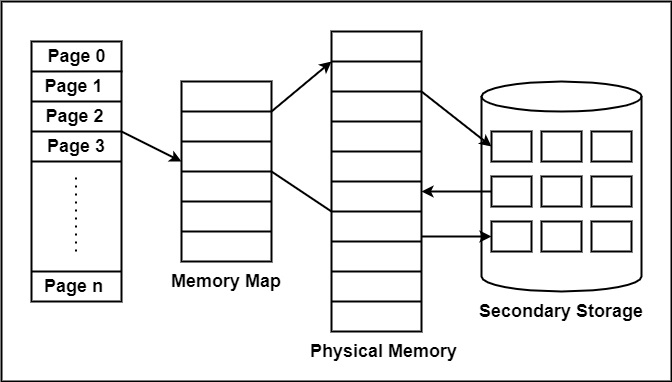
 Data Structure
Data Structure Networking
Networking RDBMS
RDBMS Operating System
Operating System Java
Java MS Excel
MS Excel iOS
iOS HTML
HTML CSS
CSS Android
Android Python
Python C Programming
C Programming C++
C++ C#
C# MongoDB
MongoDB MySQL
MySQL Javascript
Javascript PHP
PHPPhysics
Chemistry
Biology
Mathematics
English
Economics
Psychology
Social Studies
Fashion Studies
Legal Studies
- Selected Reading
- UPSC IAS Exams Notes
- Developer's Best Practices
- Questions and Answers
- Effective Resume Writing
- HR Interview Questions
- Computer Glossary
- Who is Who
What is Virtual Memory?
Virtual memory is the partition of logical memory from physical memory. This partition supports large virtual memory for programmers when only limited physical memory is available.
Virtual memory can give programmers the deception that they have a very high memory although the computer has a small main memory. It creates the function of programming easier because the programmer no longer requires to worry about the multiple physical memory available.

Virtual memory works similarly, but at one level up in the memory hierarchy. A memory management unit (MMU) transfers data between physical memory and some gradual storage device, generally a disk. This storage area can be defined as a swap disk or swap file, based on its execution. Retrieving data from physical memory is much faster than accessing data from the swap disk.
There are two primary methods for implementing virtual memory are as follows −
- Paging
Paging is a technique of memory management where small fixed-length pages are allocated instead of a single large variable-length contiguous block in the case of the dynamic allocation technique. In a paged system, each process is divided into several fixed-size ‘chunks’ called pages, typically 4k bytes in length. The memory space is also divided into blocks of the equal size known as frames.
Advantages of Paging
There are the following advantages of Paging are −
In Paging, there is no requirement for external fragmentation.
In Paging, the swapping among equal-size pages and page frames is clear.
Paging is a simple approach that it can use for memory management.
Disadvantage of Paging
There are the following disadvantages of Paging are −
In Paging, there can be a chance of Internal Fragmentation.
In Paging, the page table employs more memory.
Because of Multi-level Paging, there can be a chance of memory reference overhead.
- Segmentation
The partition of memory into logical units called segments, according to the user’s perspective is called segmentation. Segmentation allows each segment to grow independently, and share. In other words, segmentation is a technique that partition memory into logically related units called a segment. It means that the program is a collection of the segment.
Unlike pages, segments can vary in size. This requires the MMU to manage segmented memory somewhat differently than it would manage paged memory. A segmented MMU contains a segment table to maintain track of the segments resident in memory.
A segment can initiate at one of several addresses and can be of any size, each segment table entry should contain the start address and segment size. Some system allows a segment to start at any address, while other limits the start address. One such limit is found in the Intel X86 architecture, which requires a segment to start at an address that has 6000 as its four low-order bits.

